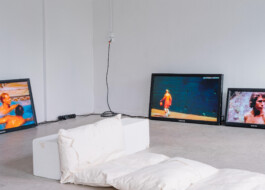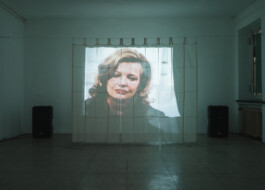
Press release:
A “wormhole” can be many things. Many things can be wormholes-in-becoming. In a straightforward sense, a wormhole is a hole in wood or fruit, burrowed by worms and worm-like creatures. It can also be a figurative hole, such as a productive digression that is both a detour and a destination in-the-making. A wormhole can describe a process, for instance, of navigating digital space, of endlessly browsing internet pages, such as Wikipedia, by way of embedded hyperlinks. The above description implies laborious slowness, which clashes with the speed-of-light velocity at which wormhole portals are traversed in sci-fi literature, film, and TV productions. There, they are, most often, functional. Although travelling through them must be mind-blowing, the lack of insight into this experience demonstrates as little narrative patience as can also be found, for instance, in shoddily haphazard exposition scenes in pornographic films and videos. An exception to the latter is a short-lived wave of US-based pre-AIDS gay-porn artistic films by filmmakers such as Jack Deveau, Joe Gage, or Wakefield Poole, where the presence and narrative significance of non-sexual intercourse scenes is expanded and made more complicated. The above example is one of the film-based references in “there is room to sprawl, time freezes in a sense,” an duo-solo exhibition by Maggessi/Morusiewicz, who employ the figure of a wormhole as a film-based trope and a film-making strategy: as a way of thinking of the medium of film in expanded and syncretic ways: as a performative sound sculpture, an immersive room installation, and a strategy of critical reading.
Displayed on multiple screens, sometimes in orchestrated dialogue and at other times unsynchronized, Maggessi/Morusiewicz employ the remixing strategy to propose fragmented and changeable narrative shapes to temporally-troubled spaces of in-betweenness, of “in the meantime.” Their reference-heavy filmwork ties together several specifically situated film/video genres and contexts under the common denominator of a “wormhole,” which, while pertaining to the above descriptions, always somehow relates to time and its measure. To quote the exhibition’s title, there is “room to sprawl” in the scenes and images that Maggessi/Morusiewicz reference in terms of their selection of sci-fi films. Coming from different places (mostly the U.S., the Soviet Union, Poland, Japan), they are all characterized by the pace that is noticeably slower than their more contemporary genre counterparts. The footage, mostly black-and-white, shows blinking flying saucers, pensive astronauts, confused space monsters, and leisurely tarantulas, all of which take time to react and to have their reactions registered on film. In the case of the pre-AIDS gay-porn artistic films, this time quality denotes the particular sprawling character of non-sexual intercourse scenes, in which the characters travel by cars or on foot, from location to location, frequently without a specific objective, or they perform daily routine activity, such as walking dogs, cooking eggs for breakfast, taking showers, going for walks, or sitting around and chatting. While undeniably heavy on explicit, non-simulated scenes of sexual encounters, these films, nevertheless, open their sex-centric plots to lingering moments of narratively unpredictable sprawling. Apart from their frequently blissful mood, such moments also normalize the films’ sexual activity, which is a politically significant agenda for Maggessi/Morusiewicz, both of whom originate from the nation states (Brasil, Poland) with a long history of complicated and violent sexual politics, largely informed by the homophobic, sexist, and anti-wom*n discourses, cultivated by the religion-heavy right-wing state policies.
“there is room to sprawl, time freezes in a sense” is an immersive space installation that combines sound, video, and sculptural works, which stem from the duo’s ongoing interest in artistic research, expanded filmmaking, multi-medial performance art, and writing. Largely based on found footage from over a hundred mostly several-decade-old films, Maggessi/Morusiewicz’s filmwork uses the format of research-based artistic practice, referencing and citing film sources that are integrated with the original footage, shot by the duo, into sprawling yet visually coherent narratives. Their anchor is frequently the soundtrack, which takes on the form of a sonic collage that combines the original tracks (written, performed, and mixed by Seth Weiner/Sadie Siegel) together with field recordings, recorded storytelling performance, samples from other audio tracks, and heterogenous ambience sound, recorded during Maggessi/Morusiewicz’s production, rehearsal, and performance sessions. The sound is an inextricable element not only of the individual works, but also of the screening’s overall material setting, composed out of the exhibition’s textile artworks: quilted screens and sitting cushions with embroidered patterns that reference film-based characters and scenes.

